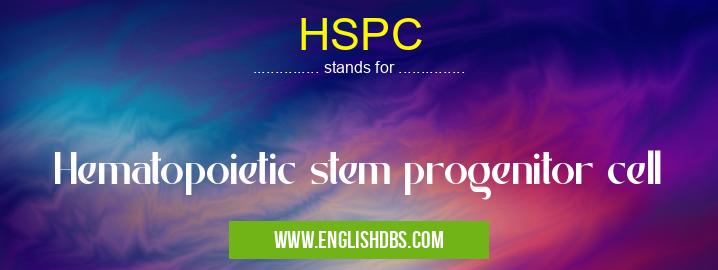What does HSPC mean in UNCLASSIFIED
Hematopoietic stem progenitor cells (HSPCs) are a type of stem cell that gives rise to all of the blood cells in the body. They exist as progenitor cells in the bone marrow and are found as clusters of immature cells called colonies. HSPCs can differentiate into a variety of other cell types, including red and white blood cells, platelets, and megakaryocytes. This capacity to differentiate allows them to help support a variety of specialized functions such as blood clotting, tissue repair, responding to infection, and forming new blood vessels. HSPCs represent an invaluable resource for medical treatments such as treating leukemia or regenerating damaged organs.

HSPC meaning in Unclassified in Miscellaneous
HSPC mostly used in an acronym Unclassified in Category Miscellaneous that means Hematopoietic stem progenitor cell
Shorthand: HSPC,
Full Form: Hematopoietic stem progenitor cell
For more information of "Hematopoietic stem progenitor cell", see the section below.
Definition
HSPC stands for Hematopoietic stem progenitor cell. It is a type of stem cell found in the bone marrow that has the capacity to differentiate into various types of blood cells such as red and white blood cells, platelets, and megakaryocytes.
Role in Medical Science
The potential uses of HSPCs have been explored extensively in recent years due to their ability to differentiate into different types of blood cells and tissues. These properties make them medically useful for treatments like regenerating damaged organs or treating conditions like leukemia when traditional treatments have proven ineffective. Studies into further usesfor HSPCs are ongoing with the aim of finding novel ways to use these valuable components from our bodies for medical benefit.
Essential Questions and Answers on Hematopoietic stem progenitor cell in "MISCELLANEOUS»UNFILED"
What is Hematopoietic Stem Progenitor Cell (HSPC)?
Hematopoietic stem progenitor cells (HSPCs) are a type of hematopoietic stem cell that can give rise to all the progenitor and mature cells of the hematopoietic system. HSPCs possess unique properties of self-renewal, allowing them to continuously replenish blood cells for life-long homeostatic maintenance in mammals.
What kinds of functions do HSPC perform?
HSPCs have a wide range of functions including producing new red blood cells to carry oxygen around the body, creating white blood cells which are part of the immune system and platelets which are integral components of clotting cascades.
How does HSPC maintain homeostasis?
During steady-state conditions, hematopoietic stem/progenitor cells continually self-renew and differentiate into committed progenitors that sequentially mature into terminally differentiated mature blood lineages. This process ensures homeostatic maintenance of circulating peripheral blood lineages necessary for physiological support.
How do HSPC differ from other stem cells?
Hematopoietic stem/progenitor cells (HSPCs) are a distinct class of tissue specific stem cell which differs from other types of even more primitive multipotent stem cells such as embryonic or induced pluripotent stem cell in many ways; e.g., tissue specificity, self-renewal capacity, migratory potential, and immune privilege.
How do researchers study HSCPs?
Researchers study hematopoietic stem/progenitor cell biology through a combination of both in vitro cellular cultures in combination with animal models such as mice that lack certain gene expressions or are deficient in certain molecular pathways known to affect HSCPs.
Are there any potential applications for HSCPs?
Potential clinical applications derived from knowledge obtained on HSCPs include treating genetic diseases through gene therapy by inserting healthy genes into the defective ones or by generating physical organoids using 3D culture technology or developing therapeutics that manipulate the balance between quiescence–activation states to promote engraftment after transplantation.
Are there any limitations associated with studying and using HSCPs?
There can be limitations associated with studying and using HSPSs due to their rare population size compared to other cell types; difficulty isolating these cells from patients; ethical issues related to obtaining them from human embryos; limited understanding about how they interact with their environment; and limited advancement in technologies available for manipulating these cells.
What types of diseases can be treated using HSPSs?
Diseases that can potentially be treated using HSPSs include sickle cell anemia, Fanconi anemia, thalassemia, primary immunodeficiency disorders such as Severe Combined Immunodeficiency and Wiskott Aldrich Syndrome among others.
Final Words:
In conclusion, HSPC stands for Hematopoietic stem progenitor cell – a type of stem cell found in the bone marrow that is capable of developing into various types of specialized cells including red blood cells, white blood cells, platelets, and megakaryocytes. Although research into potential uses for HSPCs is still ongoing they are already being utilized in medical treatments such as regenerating damaged organs or treating leukemias when more conventional treatment options fail to be successful.
